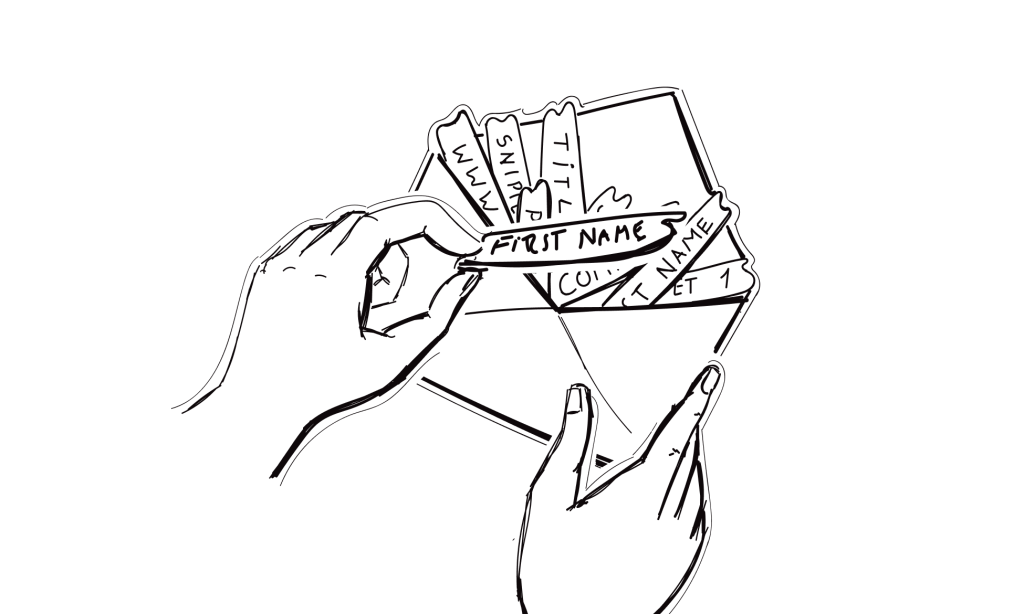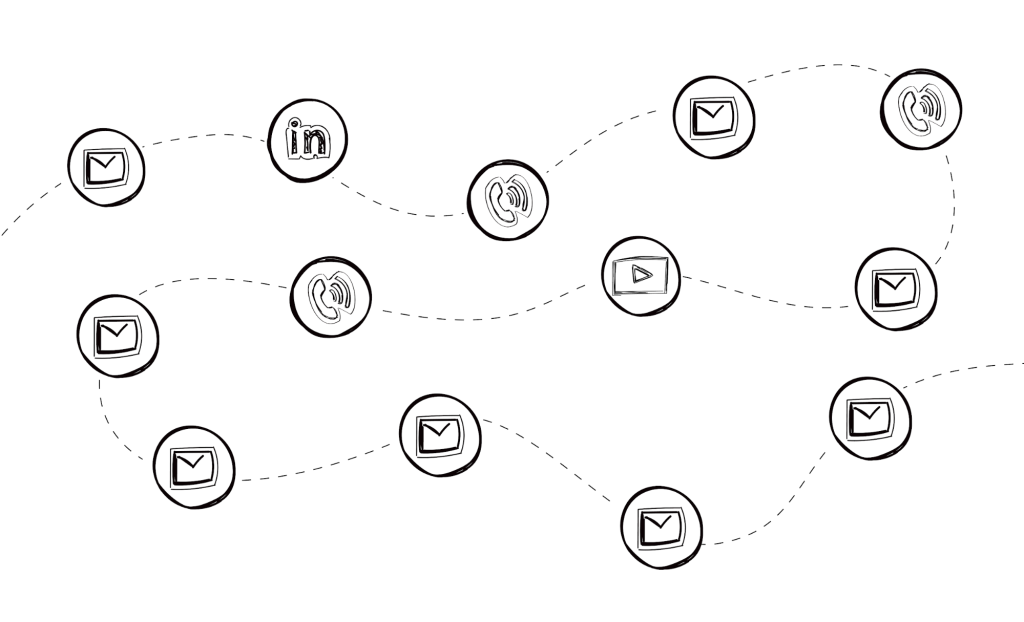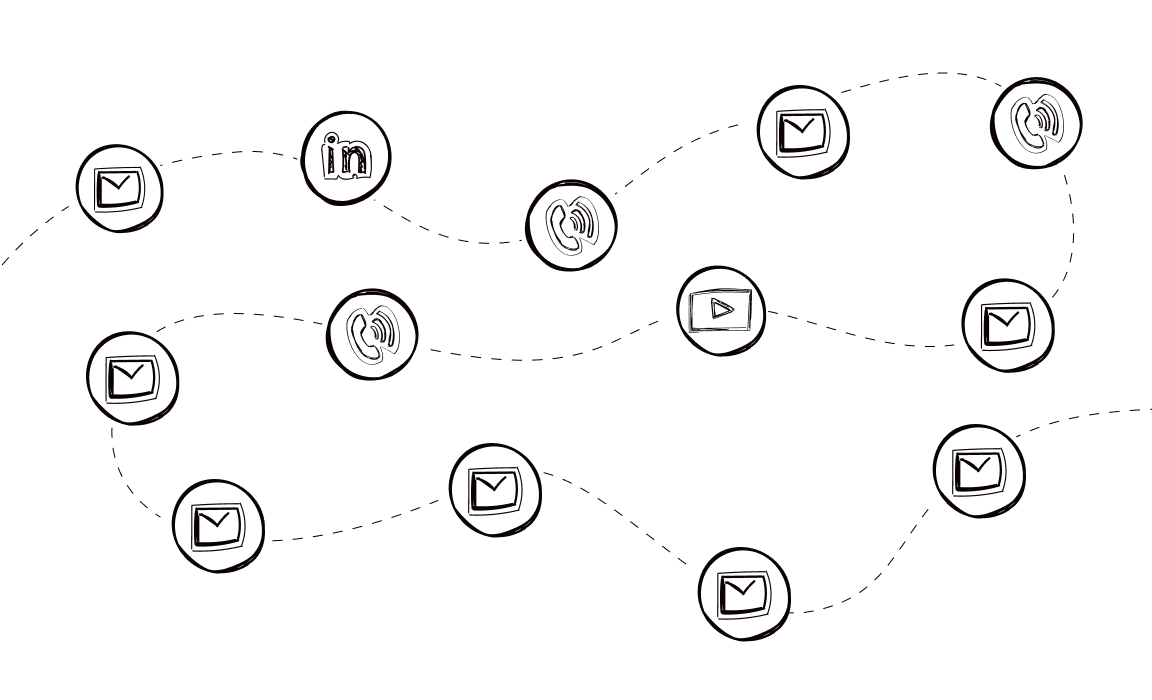Sales might be something that, at first glance, seems driven solely by spontaneity and individual talent.
Yet, the secret behind the most successful sales teams lies in their structured approach. Does a sales engagement cadence improve cold outbound sales? Let’s explore how a well-structured cadence can be your key to unlocking more deals.
What is a sales engagement cadence?

A sales engagement cadence is a structured schedule guiding sales reps through a series of actions to engage with prospects effectively.
What’s included in a sales engagement cadence?
A sales engagement cadence consists of several key steps.
Initial contact and follow-up strategy
In the sales process, the initial contact with a lead is usually a phone call or email. This first touch is super important.

The sales cadence for this part is organized into steps that make sure follow-ups happen on time, which is very important for keeping the lead interested.
These automatic actions, which are often set up through CRMs, help buyers stay focused and make sure that no prospect gets lost.
A CRM such as Salesforce can be used, for example, by a seller to schedule follow-up reminders so that no work is overlooked. This configuration maximizes time spent on each prospect in addition to optimizing the workflow. The chance of a good result rises when the message is customized to the needs of the customer and the communication goes through the right channels.
Besides, recording every contact in a customer’s file guarantees that any target assignee has access to a thorough history. A record of this kind continuously helps to preserve relationships and enables the sales staff to develop more effective, individualized engagement tactics.
Content delivery and timing
Selecting what content to provide and when is fundamental.

This strategy involves sending emails, white papers, eBooks, or case studies that align with each stage of the prospect’s buying cycle. The right content at the right time adds significant value, meeting the customer’s specific needs effectively.
For example, during the early stages of prospecting, introductory emails or articles might best serve to educate and engage potential customers.
As the prospect moves closer to a buying decision, more detailed case studies or reports provide deeper insights into how a solution can address their specific challenges.
Each piece of content requires careful planning and timing.
The sales team, guided by the cadence steps, needs to ensure they complete these actions at strategic points in the customer journey. This method helps keep communication organized and makes it more likely that the customer will reply positively.
The right cadence can help organizations improve their engagement strategies and get better results by becoming part of their daily work.
Utilization of sales tools
The marketing process transforms when you use sales tools correctly.

These tools let sales teams plan emails, manage their leads, analyze the results, and forecast sales, which makes their work much easier. Thanks to this change, the team can now focus on selling instead of getting bogged down in paperwork.
With these tools, teams can automate a lot of routine communication, making sure they talk to prospects on time without having to do each job by hand. For example, a sales rep can set up an email sequence that automatically sends tailored messages at predetermined intervals.
This way, you get consistent contact with the prospect, which improves the chances of engagement.
On top of that, the integration of these tools into the daily sales processes reduces errors and oversight.
Teams can save time and make their sales strategies more effective by automating the parts of the sales cycle that are done over and over again.
Role of personalization in engagement
Personalization in sales engagement goes beyond simply using the prospect’s name.

It requires a deep understanding of the prospect’s business challenges and tailoring conversations to address these issues. Each interaction should feel relevant and directly applicable to the prospect’s situation.
For example, if a prospect operates in the healthcare sector and faces issues with data management, a sales rep might focus discussions on how their product enhances data security and compliance.
This tailored approach shows the customer that the sales team has done their homework and understands their unique challenges.
Such personalization not only captures the prospect’s interest but also builds trust.
If the sales team shows that they understand their customer’s problems, they have a much better chance of making a sale. Normal interactions become meaningful talks that are more likely to lead to good business results.
Monitoring and analyzing performance
Sales managers need to keep an eye on and analyze success within a sales engagement strategy.

Managers can tell which methods and approaches work and which don’t by keeping track of each step of the sales cycle. This never-ending feedback loop is a must for improving general sales success and refining sales strategies.
For instance, sales managers can use tools from the Sales Cloud to monitor how sales reps handle phone calls and outreach efforts.
Managers can check to see if the steps that the reps take are in line with the desired results by looking over these records and reports. They can also check to see if automated actions in the Salesforce system (or whatever CRM you are using) are working properly.
Analyzing the performance of sales cadences helps identify high-performing strategies in high-velocity sales environments.
This way, sales teams can make sure that everyone on the team uses the best methods when talking to leads and customers by copying the strategies that work.
Ultimately, such a strategic analysis helps the organization streamline its sales process. This saves time and maximizes the value delivered to customers, which leads to improved sales outcomes.
Training and development of sales reps
You will need training sessions for your sales reps, particularly in teaching best practices in customer engagement.

Reps should get regular training on the newest tools and methods needed for high-speed sales, ensuring they do their best work.
For example, training can cover the use of Salesforce’s Lightning Experience, a component indispensable in managing sales flows and customer information efficiently.
This platform, especially within professional and enterprise editions, offers advanced features tailored to enhance the sales process.
Trainers can focus on role-specific situations, like how the person they are assigning might deal with complaints or close deals using available tools. Reps learn how to handle stress by simulating real-life situations. Then, they are ready for any task they may face in the field.
More than just honing abilities, this continuous professional growth emphasizes the value of keeping a steady channel of contact open with clients.
Every training session lets representatives realize that every contact with a consumer counts and that a transaction can be made or broken by their capacity to relate to and comprehend the other person.
Regular training investment guarantees that these skills are not only applied after training but also a crucial component of the sales team’s plan to maximize results and improve performance in general.
Ongoing optimization and adaptation
Sales cadences must always be optimized and adapted because the sales environment constantly changes.

Sales teams must continuously test and refine their strategies to stay competitive.
You can experiment with:
- Email campaigns: Experiment with different subject lines, content, personalization techniques, and send times.
- Call scripts: Test various call scripts to identify which ones yield better engagement and conversion rates.
- Follow-Up schedules: Adjust the timing and frequency of follow-ups to find the optimal cadence.
- Sales pitches: Refine value propositions and sales pitches based on customer feedback and success rates.
- Pricing strategies: Test different pricing models and discount structures to see their impact on sales volume and profitability.
- Customer segmentation: Experiment with different ways to segment customers for more targeted and effective outreach.
- Lead scoring models: Continuously refine lead scoring criteria to better identify high-potential prospects.
For instance, using the Sales Cloud, teams can easily alter their engagement tactics and monitor the impact of these changes on their performance. A sales cadence might be adjusted in Salesforce to test whether sending emails at different times of the day yields better engagement rates from leads and prospects.
Additionally, sales teams can experiment with the content of the messages they send, tailoring them more closely to the needs and interests of their targets. The outcomes of these experiments can lead to valuable insights, which are documented and reviewed to inform future strategies.
Automation plays a key role here. It allows sellers to implement changes swiftly and measure results efficiently. With regular updates and adaptations, you ensure that every part of the sales process—from initial contact to closing—is optimized to deliver maximum value to both the sales team and the customer.
We want to give you an idea of what such a Sales Engagement Cadence might look like in practice. That’s why we’ve prepared 16 templates ready for you to implement in your CRM.
16 proven sales engagement cadence templates for optimal results

To implement these steps effectively, using Sales Engagement Cadence templates can provide a structured framework. These templates help maximize consistency and efficiency and allow sales teams to follow best practices to refine their strategies for optimal engagement.
Contacts at strategic accounts
For your top-priority accounts, a mixed strategy of calls and emails ensures consistent and compelling engagement.
- Day 1: Send a personalized cold email introducing your solution.
- Day 3: Follow-up call to discuss the email sent and answer any queries.
- Day 5: Send a second email with additional details or a case study relevant to their business.
- Day 7: Call to discuss the information in the second email and set up a meeting.
- Repeat: Continue the cycle with more personalized content every two days.
Contacts at high priority accounts
These important accounts require frequent touchpoints, though less aggressively than strategic ones.
- Day 1: Send a cold email highlighting the unique benefits of your product.
- Day 25: Follow-up call to reconnect, discuss their needs, and how your solution aligns.
- Day 27: Send another email with updates or special offers.
- Day 50: Call to gauge interest and push for decision-making.
- Repeat: This cycle repeats every 25 days.
Contacts at average accounts
For medium to low-priority accounts, maintain contact without high frequency or intensity.
- Day 1: Cold email outlining your product and its relevance to their industry.
- Day 50: Follow-up call to check in and offer additional information or help.
- Day 52: Send a follow-up email reinforcing your previous discussions.
- Day 100: Call to maintain the relationship and address any new developments.
- Repeat: Continue this cycle every 50 days.
Leads with high lead score
High-scoring leads warrant a robust and aggressive approach to maximize conversion chances.
- Day 1: Send a targeted cold email based on lead-scoring insights.
- 2 hours later: Follow-up call. If there is no answer, leave a voicemail and send a brief follow-up email.
- Day 3: Another follow-up call to discuss potential concerns or questions.
- Day 5: Send an email providing detailed solutions or testimonials.
- Day 7: Call to attempt to close or advance the sales process.
- Repeat: Continue with follow-ups every 2 days until the lead converts or the score changes.
Leads with low lead scores
For leads less likely to convert, use a gentler approach to gradually build interest.
- Day 1: Cold email with general information about your product and its benefits.
- 2 hours later: Call to introduce yourself and the product briefly. If no response, leave a voicemail and a follow-up email.
- Day 3: Send another email with a more detailed explanation or an invitation to a webinar.
- Day 7: Call to discuss any thoughts they might have and answer questions.
- Day 11: Email to touch base, offering additional resources or assistance.
- Repeat: This cycle continues with less frequency and intensity, aiming to slowly build rapport.
Contacts at emerging accounts
For accounts with potential growth, utilize a nurturing approach that gradually builds engagement.
- Day 1: Send a cold email to introduce your company and highlight initial benefits.
- Day 15: Call to follow up on the email, discuss their needs, and how you can assist.
- Day 30: Send another email that includes a customer success story relevant to their industry.
- Day 45: Follow-up call to delve deeper into their specific challenges and discuss potential solutions.
- Repeat: Continue this cycle every 15 days, gradually introducing more detailed information and offers.
Contacts at lower engagement accounts
For accounts showing lower engagement or slower decision cycles, maintain contact without being too aggressive.
- Day 1: Send a concise, informative cold email outlining your value proposition.
- Day 60: Call to reintroduce your solution and assess their current needs.
- Day 90: Send an email update about new features or case studies that may be relevant.
- Day 120: Call to offer a demo or a trial, if appropriate.
- Repeat: This cycle repeats every 60 days, keeping a steady, but light touch.
Leads with medium lead score
For leads with a moderate likelihood of conversion, balance engagement intensity to foster interest.
- Day 1: Send an engaging cold email tailored to their business and pain points.
- Day 3: Follow-up call to discuss the email and understand their interest level.
- Day 10: Send a follow-up email with additional product details or an invitation to a webinar.
- Day 17: Call to discuss any questions they might have or to arrange a more detailed presentation.
- Repeat: Adjust the cycle based on response rates, with follow-ups every 7-10 days.
High-interest leads
For leads demonstrating high interest but not yet converted, intensify contact to close the sale.
- Day 1: Send a detailed cold email explaining how your solution matches their needs.
- Day 2: Follow-up call to discuss the email content and answer any initial questions.
- Day 4: Send another email with a special offer or incentive to act quickly.
- Day 6: Call to negotiate terms or finalize the sale.
- Repeat: Maintain daily contact over the first week, then every other day until the sale closes or interest wanes.
New market entrants
For potential clients in newly targeted markets or industries, adopt an educational approach.
- Day 1: Send a cold email that introduces your company and outlines key industry insights.
- Day 20: Follow-up call to discuss the insights shared and to understand their specific industry challenges.
- Day 40: Email a white paper or detailed report that addresses common challenges and showcases your solutions.
- Day 60: Call to explore potential collaboration opportunities and to gauge their interest in a demo.
- Repeat: Continue this cycle every 20 days, focusing on educating and building trust.
Seasonal accounts
For clients whose businesses peak during specific seasons, align communication with their high-impact periods.
- Day 1: Send an initial cold email before their peak season starts, introducing your solutions that can enhance their seasonal performance.
- Day 30: Follow-up call to discuss preparation for the upcoming season and how your product can help.
- 1 Month before Season Peak: Email tailored promotions or special service offerings relevant to the season.
- 2 Weeks before Season Peak: Call to finalize any pending decisions and to ensure they are ready for the season.
- Post-Season: Review call to discuss outcomes and plan for the next cycle.
- Repeat: Adjust the timeline based on the seasonal calendar, focusing efforts just before and after their peak business times.
Technology upgrade leads
For leads considering upgrades or changes in their technology stack, focus on technical details and support.
- Day 1: Send a cold email with an overview of your tech solutions and integration capabilities.
- Day 7: Follow-up call to understand their current tech environment and needs.
- Day 14: Email links to webinars, tech demos, or case studies that align with their tech interests.
- Day 21: Call to offer a personalized demo or a consultation with a tech specialist.
- Repeat: Keep the cycle tight with weekly contacts, focusing on providing technical support and information.
Low engagement but high potential
For leads with significant potential but low engagement, use a mix of educational and promotional strategies.
- Day 1: Send a cold email that highlights unique aspects of your solution not covered in usual pitches.
- Day 15: Call to softly touch base, offering help with any information or decision processes.
- Day 30: Email a special report or analysis that provides value even if they do not purchase immediately.
- Day 45: Call to discuss the report and any new developments in their requirements or your offerings.
- Repeat: Extend contact intervals to 15 days, providing substantial content each time to build interest gradually.
Start-up ventures
For engaging with fast-moving start-up companies, emphasize agility and growth potential.
- Day 1: Send a cold email that highlights how your products or services can scale with their growth.
- Day 10: Follow-up call to discuss their current challenges and how your solutions fit their growth trajectory.
- Day 20: Email a case study showing a similar start-up that succeeded using your services.
- Day 30: Call to address any feedback from the case study and to discuss potential pilot projects.
- Repeat: Maintain a 10-day interval, focusing on rapid response and adaptability to their fast-paced environment.
Corporate divisions
For contacts within larger corporate structures, focus on department-specific solutions and compliance.
- Day 1: Send a cold email tailored to the specific division’s needs, emphasizing compliance and integration with corporate standards.
- Day 15: Call to delve deeper into their specific departmental challenges and discuss tailored solutions.
- Day 30: Email detailed documentation or product specifications that meet corporate governance standards.
- Day 45: Call to follow up on the documentation and to set up a department-wide demonstration.
- Repeat: Keep a steady 15-day interval, providing detailed and compliant solutions that cater to corporate policies.
International leads
For prospects in different countries, consider cultural nuances and time zones in your approach.
- Day 1: Send a cold email introducing your company and products, tailored to the cultural and business practices of the prospect’s country.
- Day 20: Follow-up call at a time convenient for their time zone, discussing how you can support their local and global needs.
- Day 40: Email local case studies or testimonials from similar regions, highlighting your global footprint and local expertise.
- Day 60: Call to discuss any questions raised by the case studies and to explore potential barriers such as language or logistics.
- Repeat: Extend the cycle to every 20 days, focusing on building trust and understanding cross-cultural business dynamics.
Take your sales engagement to the next level
To keep up regular and successful interaction with different lead kinds, cold email and cold call cadence implementation is essential. Dealing with startups, corporate divisions, or foreign markets—the appropriate cadence guarantees timely, relevant, and highly individualized outreach activities.
To streamline and optimize your sales cadences, consider using a tool like Woodpecker.co. Woodpecker.co specializes in automating and personalizing cold emails and follow-ups, ensuring your messages hit the right note at the right time. With advanced scheduling, personalization features, and performance tracking, Woodpecker.co is the ideal partner to enhance your sales engagement strategies.
Start optimizing your outreach today and see the difference that a tailored and automated approach can make. Visit Woodpecker.co to learn more and sign up for a free trial.

